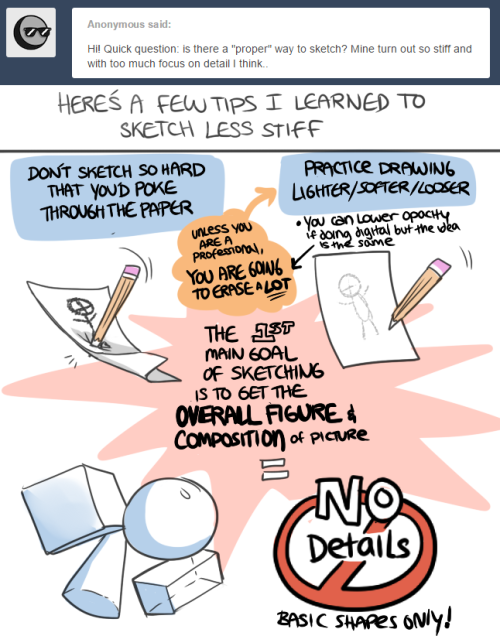Hi! I Want To Draw People With A Lot Of Emotion Captured, But I Don't Really Know How To Do It So That
Hi! I want to draw people with a lot of emotion captured, but I don't really know how to do it so that the viewer feels something. I want to show more emotion, I guess? (This was really unclear, I know :0) Thank you so much!
What a great question, @everchangingotps!
I think studying anatomy helps a lot. Facial muscles are a bit complex, and they move in different ways to make the frowns and smiles happen!
Here’s a few great resources I found:
Human Anatomy Fundamentals, Mastering facial Expressions - super comprehensive. Definitely worth the read!
Muscles of Facial Expression - Anatomyzone
Drawing facial expressions - Xia Taptara on Youtube
Folder of Facial Expression Tutorials! Super useful
Expression tutorial by shingworks - cartoon style
If you liked this post, please consider reblogging this post so more artists can see it!
Also it would mean the world to me if you checked out my art at @astrikos!
Thank you for your continued support!
More Posts from Risingstarling and Others

Very true







Checklist for character development.
Created by myself, compiled from questions gleaned from several sources, and some of my own additions.
It should be noted, that not every character will check every one of these things off. It is not REQUIRED to have all this information, but this checklist is, rather, a guideline for helping you think of your character as an entire, three dimentional being with thoughts, feelings, possessions, contradictions and background.
A character is 20% revealed to the reader, 80% writer/author/Mun knowledge. What the Reader sees is just the tip of the iceburg, but without the other 80% the character can’t help but come off feeling shallow. There’s nothing beneath the surface - KNOWING as much bout your character as possible, instrinsicly, in detail, intimately, can do nothing but help build believability and dimension to your character.
Use only the things on this list that you feel are important, but I would like to remind you that the reader learns a lot about a character NOT through exposition (that’s kind of a cheat, and always feels , to me, like a rather clunky way of conveying knowlege), but through their actions, quirks, thoughts, and even through the things they own and carry with them. What kind of food they eat and how they eat it. What they wear. What they carry in their wallets. I encourage you, as writers, to consider these things when creating a character, and encourage you MORE to leave the exposition out and tell us about your character through these other means!
If nothing else, this will give you a LOT to work with when writing with your character. Maybe it’ll spur you to write about the character’s parents. Or the relationship between them and their family. Maybe you’ll find yourself inspired to write something about how they lost everything in a fire - and the importance each remembered lost item held.
There is certainly no rule that says you HAVE to do it this way, but invariably, the most memorable characters are the ones that we as readers can relate with. It’s hard to relate with just words - but people - with beliefs and dreams and fears - that’s something we can get behind.
I certainly hope you find this useful, and since so many have been inclined to reblog and like this, I shall endeavor to add more character creation and writing tips, lists and excercises up on this blog!




Sketching Tips
3 Study Methods You Should Use More Often
This was originally for an article writing assignment, but I thought “why not write something I can also post on my blog?” so here are three study methods that I haven’t seen a lot of in the studyblr community but are definitely worth mentioning.
The Leitner System
Flash cards have remained one of the most popular ways to study. Some people use them to memorize vocabulary, remember answers to specific questions, or even associate dates with events. Although the use of flash cards is convenient, their effectiveness has been reduced due to most people’s habits of prioritizing each card equally and therefore spending too much time memorizing the information on them.
The Leitner System, created by a German popularizer of science named Sebastian Leitner, is a more efficient method of studying that implements the concept of spaced repetition. All the cards start off in one pile. You would first scan through these cards, then test yourself. Each card you answer correctly goes to a second pile, while those you answer incorrectly should be revised then placed at the bottom of the pile. When you review the cards in the second pile and get them correct, they will be promoted to a third pile. An incorrect card will always get demoted to the first pile, even if they had previously been promoted to the last pile.
The reason why this method is so effective is that you end up reviewing the first pile of cards more frequently—the cards you don’t know very well. Some people choose to review their Stack 1 cards every day, Stack 2 cards every other day, Stack 3 cards once every three days, and so on.
Once all your cards have been promoted to the highest box, study them thoroughly and then start over. The continuous revision trains your speed so that you may reach fluency, which allows you to recall the information faster.

Timed Memorization
The name tells it all: you memorize a certain text within a time limit, normally around five to ten minutes depending on your fluency and memorization abilities. When the timer starts, you begin memorizing. When time is up, you flip to the next page, even if you haven’t finished the previous page yet. Continue until you’ve gone through all your material.
Timed memorization helps you to discipline yourself because your brain thinks that there’s no time for messing around; you have to do this here and now. Make sure to repeat the things you missed and revise everything frequently. This method is actually one of the most effective for cramming as it gives a better coverage than if you spend a whole half hour memorizing one subtopic.
The Memory Palace or Mind Palace
Sound familiar? In BBC’s Sherlock, the ‘highly functioning sociopath’ uses this method to remember vital information and facts. A mind palace is a systematic arrangement of information, each detail corresponding to a specific object in a familiar place. To ensure that you really remember everything, the objects have to appear shocking and conspicuous.
Here’s an example: if I wanted to memorize “crimson, 11, delight, petrichor (the smell after rain)”, aside from imagining Amy Pond or the Doctor saying it, I would first choose a place, let’s say my school. I’d imagine myself walking up to the front gate and seeing that the entire building has been painted the color of blood—crimson. The building would then rise as though it were lifted from the earth and crumble into rubble, controlled by Eleven, the character from Stranger Things. Now, since I can’t really picture delight specifically, I’d probably end up visualizing a colossal sign that simply reads “delight” posted in front of my school. As for petrichor, I’d imagine curves rising out of the puddles on the asphalt after a rainy night, a visual representation of the smell of the rain. Of course, these visualizations have been created to suit my memory. (I wouldn’t know if you watched Stranger Things.)
I used this method when memorizing case studies for geography, although I chose to visualize fictional places from television series and cartoons. Some people do opt to create artificial places, but these often become blurry and are easily forgotten.
As with any study method, repetition is vital to storing the information in your long-term memory. Visit your “palace” as often as you can. Soon enough, you’ll remember the data as well as you remember the place associated with the data.
So there you have it, three lesser known methods of studying that have proven to be immensely efficient. Now, there is no “correct” way to study, but there are methods that can ease your learning process.
“Pick your battles. Pick… pick fewer battles than that. Put some back. That’s too many.”
— Tsuna at Hibari

One of the most important scenes in anime history







-
 the-knife-with-an-edge liked this · 11 months ago
the-knife-with-an-edge liked this · 11 months ago -
 ffrposties reblogged this · 1 year ago
ffrposties reblogged this · 1 year ago -
 nefarious-virgo liked this · 2 years ago
nefarious-virgo liked this · 2 years ago -
 guiltilycomfortable liked this · 3 years ago
guiltilycomfortable liked this · 3 years ago -
 zeroplasma liked this · 3 years ago
zeroplasma liked this · 3 years ago -
 trans-wirt liked this · 3 years ago
trans-wirt liked this · 3 years ago -
 technogeekmituna-arthelpreblogs reblogged this · 3 years ago
technogeekmituna-arthelpreblogs reblogged this · 3 years ago -
 tutoriarts reblogged this · 3 years ago
tutoriarts reblogged this · 3 years ago -
 deararistoteles reblogged this · 4 years ago
deararistoteles reblogged this · 4 years ago -
 chalpurnia liked this · 4 years ago
chalpurnia liked this · 4 years ago -
 kauvi liked this · 5 years ago
kauvi liked this · 5 years ago -
 teambooksforlife liked this · 5 years ago
teambooksforlife liked this · 5 years ago -
 zeroplasma reblogged this · 5 years ago
zeroplasma reblogged this · 5 years ago -
 greennlove reblogged this · 5 years ago
greennlove reblogged this · 5 years ago -
 drewwwbydoobydoo liked this · 5 years ago
drewwwbydoobydoo liked this · 5 years ago -
 porco-galliard liked this · 5 years ago
porco-galliard liked this · 5 years ago -
 laughytaffyowo liked this · 5 years ago
laughytaffyowo liked this · 5 years ago -
 killmepieceofshit liked this · 5 years ago
killmepieceofshit liked this · 5 years ago -
 seesbean reblogged this · 5 years ago
seesbean reblogged this · 5 years ago -
 art-refs-and-resources reblogged this · 5 years ago
art-refs-and-resources reblogged this · 5 years ago -
 3motive-s4turdays liked this · 5 years ago
3motive-s4turdays liked this · 5 years ago -
 bawarka liked this · 5 years ago
bawarka liked this · 5 years ago -
 sleepipillow reblogged this · 5 years ago
sleepipillow reblogged this · 5 years ago -
 ryuuzamei liked this · 5 years ago
ryuuzamei liked this · 5 years ago -
 lasisgood reblogged this · 5 years ago
lasisgood reblogged this · 5 years ago -
 lasisgood liked this · 5 years ago
lasisgood liked this · 5 years ago -
 rosifire reblogged this · 5 years ago
rosifire reblogged this · 5 years ago -
 innerbearjudgepeach liked this · 5 years ago
innerbearjudgepeach liked this · 5 years ago
Right now this is just anything that comes to mind since I'm a complete noob at tumblr. I've been hearing about it for years but I never really felt like I had anything to say. Well all that has changed now and I figured I'd see what all the hype about tumlr is really about. Anyway don't take anything I say too seriously for now...I'll probably change it later when I become more comfortable with this website.
168 posts